The Silk Route – August 2007
We started our journey along the Silk Routes with a couple of days in Almaty the former capital of Kazakhstan. The city was a mixture of old and new, clean and not so clean. However, some of the sights, such as the Cathedral shown here, made our time there worthwhile. Then we headed into China’s Xinjiang Province and saw our first yurts as we climbed high into the mountains. Sayram Lake (at 2000M above sea level) was supposed to be idyllic
according to the brochure but it forgot to mention we were staying in very basic accommodation (flooded bathroom and no water in the morning) next to a construction site for a new major road, railway line and tunnel. Despite this we had a very pleasant evening and morning pottering around the lake before heading to Yining and a luxury hotel! What a contrast with the previous night. We ate down town and enjoyed a true Chinese feast sitting outside the restaurant watching the crowds wander by (brilliant).
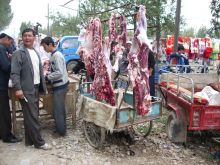
The next day we headed to the Dong Animal Market a truly new experience with deals done by handshakes amid apparent chaos. Besides the animal selling there were all sorts of traditional market stalls and some perhaps new to us! The market was really busy but the locals all made us very welcome.
All too soon we left and headed for the Nalati grasslands and an afternoon walking high in the mountains. Annie and I thoroughly enjoyed ourselves despite some rain and muddy paths. The camera does not seem able to capture the breathtaking views.
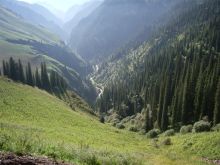 The next morning we headed over the Tien Shan Mountains in 4x4s. Actually we climbed to 3800M and then went through a very long tunnel before descending again. The journey took 12 hours on a road that was nearly impassable in places. But at least there was not a lot of traffic and we were able to enjoy constantly changing but almost always beautiful scenery. Click here to see some more photos of this phase of our journey.
The next morning we headed over the Tien Shan Mountains in 4x4s. Actually we climbed to 3800M and then went through a very long tunnel before descending again. The journey took 12 hours on a road that was nearly impassable in places. But at least there was not a lot of traffic and we were able to enjoy constantly changing but almost always beautiful scenery. Click here to see some more photos of this phase of our journey.
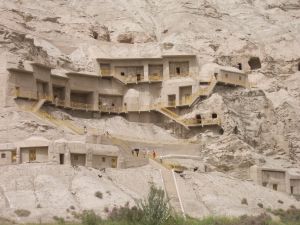 The trip over the mountains ended in Kuqa (pronounced Kuche) where we stayed for a couple of days in a delightful hotel (toilets and shower in working order). We had a day exploring the Buddhist history of the area and visited the ruins of the ancient capital Subashi (3rd century) and the Kizilgaha Beacon (said to be the best preserved beacon on the Silk Road) before heading to the Kizil 1000 Buddha Caves carved out of the hillside and dating back to the 5th century.
The trip over the mountains ended in Kuqa (pronounced Kuche) where we stayed for a couple of days in a delightful hotel (toilets and shower in working order). We had a day exploring the Buddhist history of the area and visited the ruins of the ancient capital Subashi (3rd century) and the Kizilgaha Beacon (said to be the best preserved beacon on the Silk Road) before heading to the Kizil 1000 Buddha Caves carved out of the hillside and dating back to the 5th century.
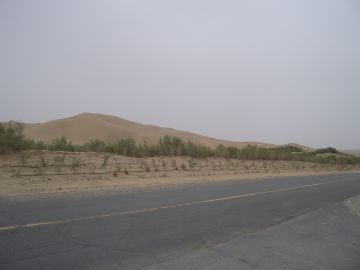 We left Kuqa for a 12 hour journey across the Taklamakan Desert (the Desert of no return). Well, it should have taken 12 hours but we took well over 14 as a result of breakdowns. The main part of the journey was along a 540km highway through the sands with only 1 garage and shop in the middle. Just mile upon mile of sand with a small belt of greenery on either side of the road to stop the sand encroaching.
We left Kuqa for a 12 hour journey across the Taklamakan Desert (the Desert of no return). Well, it should have taken 12 hours but we took well over 14 as a result of breakdowns. The main part of the journey was along a 540km highway through the sands with only 1 garage and shop in the middle. Just mile upon mile of sand with a small belt of greenery on either side of the road to stop the sand encroaching. 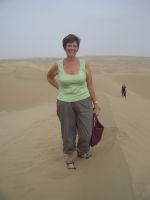 The greenery was irrigated by water from wells (with British made pumps) at 4km intervals. It was exceedingly hot during the day and hard for us to imagine that it would be minus 25C later in the evening. I even managed to get Annie to pose for a photo on the sand!! And so we arrived at our hotel in Ming Feng quite late. Dinner was fine but we awoke to a flooded bathroom but no water in the cold tap (filled the Loo with hot water from the showerhead!). We did not have the chance to explore Ming Feng as we had to move on to Hotan via a lovely quiet town called Keriya. Here we walked down sleepy lanes past roadside stalls and shops. Children seemed to hide in every entrance waiting for us.
The greenery was irrigated by water from wells (with British made pumps) at 4km intervals. It was exceedingly hot during the day and hard for us to imagine that it would be minus 25C later in the evening. I even managed to get Annie to pose for a photo on the sand!! And so we arrived at our hotel in Ming Feng quite late. Dinner was fine but we awoke to a flooded bathroom but no water in the cold tap (filled the Loo with hot water from the showerhead!). We did not have the chance to explore Ming Feng as we had to move on to Hotan via a lovely quiet town called Keriya. Here we walked down sleepy lanes past roadside stalls and shops. Children seemed to hide in every entrance waiting for us. 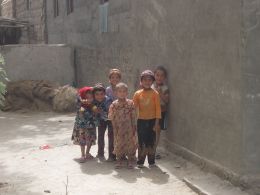
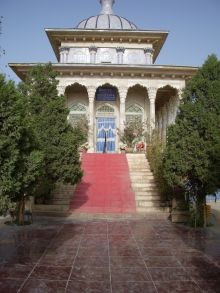
Eventually, we arrived at Yarkand which was one of the largest trading posts on the Silk Road. There are many old buildings including the picturesque Altyn Mosque and the beautiful tomb of Aman Isa Khan a famous poetess (shown left) Click here to see some more photos of this phase of our journey.
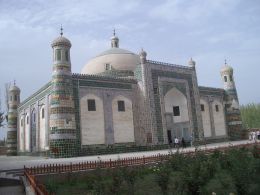 Our next city was Kashgar a major and thriving centre where we came across many other western tourists – the first we had seen since entering China. There were some major historical sights especially the tomb of Abakh Khoja (built in 1640) which is the holiest site in Xinjiang Province and stood next to a very old Mosque which had amazingly colourful and kept standing by a great inclined tree trunk. Apart from these and the Id Kah Mosque (capacity 10000 people and built in 1442), Kashgar was quite modern
Our next city was Kashgar a major and thriving centre where we came across many other western tourists – the first we had seen since entering China. There were some major historical sights especially the tomb of Abakh Khoja (built in 1640) which is the holiest site in Xinjiang Province and stood next to a very old Mosque which had amazingly colourful and kept standing by a great inclined tree trunk. Apart from these and the Id Kah Mosque (capacity 10000 people and built in 1442), Kashgar was quite modern 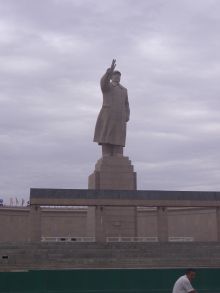 but in places you could see quite clearly where buildings had been erected on the old city walls. Kashgar also has the largest statue of Mao Tse Tung which stands 18 metres high. We certainly enjoyed exploring the centre of Kashgar on our own especially the myriad of streets, that were in fact small alleyways of houses and shops. The paving was different for no-through streets and through streets so at least we knew whether there was an exit! We also had dinner in a Uighur House – quite a magnificent spread of fruits, nuts and salads which were enjoyed before they brought the soup and meat courses. We had melon to follow (fact – there are more than 1200 types of melon) and by the time we had finished we were glad to get up off the floor – sitting on the floor to eat a 4 course meal when you are not used to it is quite hard! The hosts also arranged a display of local dancing and music. The dancers’ costumes were very colourful but only dated back about a generation suggesting that the entertainment was perhaps modern rather than traditional. Nevertheless, we certainly had a brilliant evening.
but in places you could see quite clearly where buildings had been erected on the old city walls. Kashgar also has the largest statue of Mao Tse Tung which stands 18 metres high. We certainly enjoyed exploring the centre of Kashgar on our own especially the myriad of streets, that were in fact small alleyways of houses and shops. The paving was different for no-through streets and through streets so at least we knew whether there was an exit! We also had dinner in a Uighur House – quite a magnificent spread of fruits, nuts and salads which were enjoyed before they brought the soup and meat courses. We had melon to follow (fact – there are more than 1200 types of melon) and by the time we had finished we were glad to get up off the floor – sitting on the floor to eat a 4 course meal when you are not used to it is quite hard! The hosts also arranged a display of local dancing and music. The dancers’ costumes were very colourful but only dated back about a generation suggesting that the entertainment was perhaps modern rather than traditional. Nevertheless, we certainly had a brilliant evening.
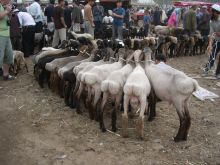 Kashgar continued to entrance us when we went to the massive Sunday Market. There were hundreds of animals, sheep, goats, cattle, donkeys and horses all being bought and sold with a firm and long lasting handshake. You can see the J-Lo sheep in the picture – so called because of the sheep barbers (yes there were people cutting the wool on the rumps) efforts. The market extended beyond animals to fruit and vegetables but also every thing you need to live including brand new donkey carts made in the traditional way.
Kashgar continued to entrance us when we went to the massive Sunday Market. There were hundreds of animals, sheep, goats, cattle, donkeys and horses all being bought and sold with a firm and long lasting handshake. You can see the J-Lo sheep in the picture – so called because of the sheep barbers (yes there were people cutting the wool on the rumps) efforts. The market extended beyond animals to fruit and vegetables but also every thing you need to live including brand new donkey carts made in the traditional way.
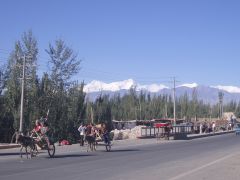 While in Kashgar we took the opportunity to travel along the Karakorum Highway towards the China-Pakistan Border. This was something we had really hoped to do and were not disappointed. The scenery was amazing – there is no other word for it. The road started out towards the Pamir Mountains and we could see the snow capped mountains (some over 7000m) under brilliant sunshine as we drove through towns and villages where there was hustle and bustle as the markets were getting going.
While in Kashgar we took the opportunity to travel along the Karakorum Highway towards the China-Pakistan Border. This was something we had really hoped to do and were not disappointed. The scenery was amazing – there is no other word for it. The road started out towards the Pamir Mountains and we could see the snow capped mountains (some over 7000m) under brilliant sunshine as we drove through towns and villages where there was hustle and bustle as the markets were getting going. 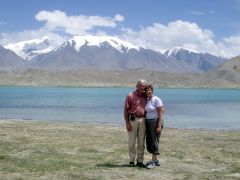 As we got higher so the scenery changed and the mountains varied in colour from lush green through brown rock to one section of silver grey. These were sand mountains that on the one hand seemed out of place at such high altitude but on the other seemed totally right. We eventually arrived at Kara Kul Lake and enjoyed a peaceful hour and a half exploring before heading back. Although it was a long day it was worth every minute of the many hours spent on the bus – Breathtaking.
As we got higher so the scenery changed and the mountains varied in colour from lush green through brown rock to one section of silver grey. These were sand mountains that on the one hand seemed out of place at such high altitude but on the other seemed totally right. We eventually arrived at Kara Kul Lake and enjoyed a peaceful hour and a half exploring before heading back. Although it was a long day it was worth every minute of the many hours spent on the bus – Breathtaking.
Click here to see some more photos of this phase of our journey.
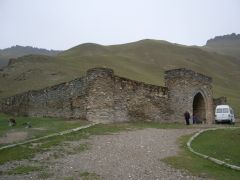 After Kashgar we headed out of China into Kyrgyzstan through the Torugart pass. The border crossing, high in the mountains at 3752m, had a 100km of ‘no-man’s-land’ between the exit and entry points. We traveled through dramatic mountain scenery to spend our first night at Tash Rabat, an old fortified stone caravanserai. The building was totally out of character for the surroundings – a narrow valley with a winding track that was hard to recognize as a major trading route of the past.
After Kashgar we headed out of China into Kyrgyzstan through the Torugart pass. The border crossing, high in the mountains at 3752m, had a 100km of ‘no-man’s-land’ between the exit and entry points. We traveled through dramatic mountain scenery to spend our first night at Tash Rabat, an old fortified stone caravanserai. The building was totally out of character for the surroundings – a narrow valley with a winding track that was hard to recognize as a major trading route of the past. 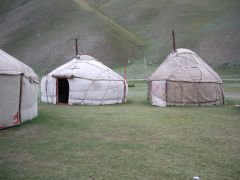 Our accommodation was a yurt which we shared with 5 others. There was a stove in the middle and as it got colder and colder in the evening we understood why. It was just unfortunate, that when it was lit, it gave out so much heat that Gerry had to go outside to cool off. However, by morning, the fire was out and it was very cold – still minus 4 degrees centigrade a couple of hours after sunrise. As we started on our travels on main roads that were no better than the worst country lanes in the UK, we passed several nomad camps some were just one yurt but with signs of domestication such as solar panels, satellite dish, a child’s bike with stabilizers
Our accommodation was a yurt which we shared with 5 others. There was a stove in the middle and as it got colder and colder in the evening we understood why. It was just unfortunate, that when it was lit, it gave out so much heat that Gerry had to go outside to cool off. However, by morning, the fire was out and it was very cold – still minus 4 degrees centigrade a couple of hours after sunrise. As we started on our travels on main roads that were no better than the worst country lanes in the UK, we passed several nomad camps some were just one yurt but with signs of domestication such as solar panels, satellite dish, a child’s bike with stabilizers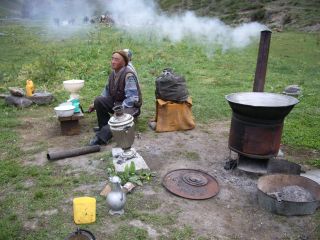 and a man at work making butter from mare’s milk. As the day progressed it got warmer and warmer reaching plus 35 C by noon. We visited Issy-Kul Lake a holiday resort but were disappointed with the cleanliness and the run down nature of the infrastructure. Nothing seemed to have been done since the country got its independence from the USSR yet it was a different story when we got to the capital Bishkek. We stayed high in the mountains again but this time it was because the Government had thrown us out of our hotel to accommodate Presidents of Russia, China and other countries in the region for a conference. Nevertheless, we did manage to spend an afternoon exploring the city.
and a man at work making butter from mare’s milk. As the day progressed it got warmer and warmer reaching plus 35 C by noon. We visited Issy-Kul Lake a holiday resort but were disappointed with the cleanliness and the run down nature of the infrastructure. Nothing seemed to have been done since the country got its independence from the USSR yet it was a different story when we got to the capital Bishkek. We stayed high in the mountains again but this time it was because the Government had thrown us out of our hotel to accommodate Presidents of Russia, China and other countries in the region for a conference. Nevertheless, we did manage to spend an afternoon exploring the city.
The next leg of the journey took us across the border into Kazakhstan and a long drive across that country to the border with Uzbekistan. The crossing was an experience – throngs of people who did not like queuing so much so that they tried to leave the country through the immigration channel. 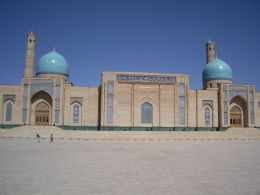 The border guards hit and kicked people and threw them out – sounds bad, but in fact they were very restrained – they could have used their batons or guns! We got to Tashkent exhausted, hot and dehydrated to find a lovely small hotel with a 24 hour restaurant and bar and a delightful enclosed courtyard – what an oasis. Tashkent was a great city – many lovely buildings and memorials including the earthquake memorial (see below) above the epicentre of the great quake of 1966.
The border guards hit and kicked people and threw them out – sounds bad, but in fact they were very restrained – they could have used their batons or guns! We got to Tashkent exhausted, hot and dehydrated to find a lovely small hotel with a 24 hour restaurant and bar and a delightful enclosed courtyard – what an oasis. Tashkent was a great city – many lovely buildings and memorials including the earthquake memorial (see below) above the epicentre of the great quake of 1966. 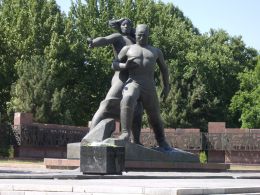 The roads were wide with little traffic and there were fountains and parks everywhere. Indeed, a city where we would have been quite happy to stay another day (unusual for Annie and me as we normally can’t wait to get away from the crowds). We obviously had to change some money. The largest Uzbek note is for 1000 Som (40p) but as they don’t use credit or debit cards, such notes are hoarded by people and generally the highest denomination available is the 500 Som note. We joked about having to go out with 2 or 3 bricks of notes!
The roads were wide with little traffic and there were fountains and parks everywhere. Indeed, a city where we would have been quite happy to stay another day (unusual for Annie and me as we normally can’t wait to get away from the crowds). We obviously had to change some money. The largest Uzbek note is for 1000 Som (40p) but as they don’t use credit or debit cards, such notes are hoarded by people and generally the highest denomination available is the 500 Som note. We joked about having to go out with 2 or 3 bricks of notes!
From Tashkent we traveled for 5and a half hours along good roads surrounded by flat plains of what looked like corn stubble but was very dry yellow grass. We discovered that Uzbekistan only has about 40 days of very cold winter and with a hot Mediterranean climate and plenty of irrigation there are lots of fruit and veg. Eventually, we arrived at Samarkand just as preparations were in full swing to celebrate 2750 years as a city. Our first port of call was our hotel – an Aladdin’s cave of antiques that were the pride and joy of the proprietor (a professor of English at the university until he gave it up to run a hotel and antique business because the money in teaching was so bad). Samarkand was very beautiful and steeped in history with massive old buildings around Registan Square. We learned, with great surprise that many of the
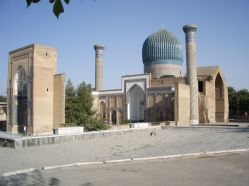
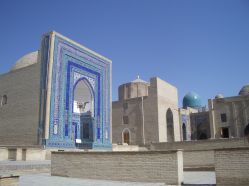
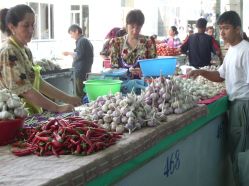 Muslim monuments and buildings had been restored during Soviet times with considerable care and lots of money. Eating in little restaurants was interesting if the staff did not speak english and there was no written menu. But we survived thanks to a helpful young waiter, sign language and choosing raw meat from the ‘kitchen’ (a BBQ on the pavement). We also visited the main Bazaar (more than 750 stalls) and thoroughly enjoyed looking at the beautiful displays of fruit and vegetables.
Muslim monuments and buildings had been restored during Soviet times with considerable care and lots of money. Eating in little restaurants was interesting if the staff did not speak english and there was no written menu. But we survived thanks to a helpful young waiter, sign language and choosing raw meat from the ‘kitchen’ (a BBQ on the pavement). We also visited the main Bazaar (more than 750 stalls) and thoroughly enjoyed looking at the beautiful displays of fruit and vegetables.
Click here to see some more photos of this phase of our journey.
From Samarkand we headed across the desert to Nurati where we had lunch in a local house. The house looked uninspiring from the road, but once we got inside we found that a couple of the rooms had been turned into quite sumptuous dining rooms for the tourist season. 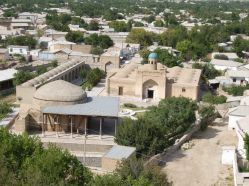 We sat cross legged on the floor at the low table and enjoyed a great spread of breads, salads, fruits and nuts before tucking into soup (rehydrated noodles with a sachet of sauce for the vegetarians) and, already full, were then presented with the main course of meat(or not if you were veggie), rice and carrots. After lunch in really hot conditions we visited the ruins of Alexander the Great’s Karay Fortress. Not a lot left now, but it stands on a hill overlooking an interesting mosque complex and a well which is the junction of 5 underground rivers and filled with sacred trout.
We sat cross legged on the floor at the low table and enjoyed a great spread of breads, salads, fruits and nuts before tucking into soup (rehydrated noodles with a sachet of sauce for the vegetarians) and, already full, were then presented with the main course of meat(or not if you were veggie), rice and carrots. After lunch in really hot conditions we visited the ruins of Alexander the Great’s Karay Fortress. Not a lot left now, but it stands on a hill overlooking an interesting mosque complex and a well which is the junction of 5 underground rivers and filled with sacred trout.

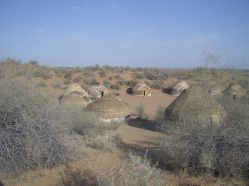 Back on our bus we travelled 70km through desolate desert/steppe to the small and very dusty town of Yangigazgan (no idea how it is pronounced) where we transferred to a small 15 year old 4 wheel drive bus to take us the last 7 km across the sand to our Yurt Camp. The camp was set in a depression and comprised 7 traditional felt yurts as well as a permanent concrete yurt which acted as the dining room. The kitchen was in a very old metal caravan.
Back on our bus we travelled 70km through desolate desert/steppe to the small and very dusty town of Yangigazgan (no idea how it is pronounced) where we transferred to a small 15 year old 4 wheel drive bus to take us the last 7 km across the sand to our Yurt Camp. The camp was set in a depression and comprised 7 traditional felt yurts as well as a permanent concrete yurt which acted as the dining room. The kitchen was in a very old metal caravan. 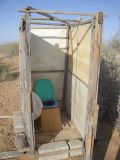 It was almost magical – quiet, beautiful soft sand and nothing else apart from a loo on a sand dune (a real toilet in a wooden box). Supper was a magnificent spread of salads (cabbage, carrot, aubergine, tomato, peppers etc with bread, dried fruit and nuts. Then came great plates of peppers stuffed with meat or veggie stew and of course water melon for afters. The meal also included bottled water and half a bottle of vodka between each couple. Replete and a little heady in some cases, we headed for bed but not without looking at the beautiful night sky – no clouds and no light pollution.
It was almost magical – quiet, beautiful soft sand and nothing else apart from a loo on a sand dune (a real toilet in a wooden box). Supper was a magnificent spread of salads (cabbage, carrot, aubergine, tomato, peppers etc with bread, dried fruit and nuts. Then came great plates of peppers stuffed with meat or veggie stew and of course water melon for afters. The meal also included bottled water and half a bottle of vodka between each couple. Replete and a little heady in some cases, we headed for bed but not without looking at the beautiful night sky – no clouds and no light pollution.
After a surprisingly good night’s sleep and a hearty breakfast we headed back over the desert to rejoin our proper bus and head for Bokhara. 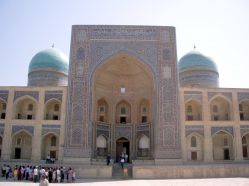 Considered by some to be the ‘Bastion of Islam’, Bokhara has more than 140 monuments! These range from the Emir’s Palace – a massive walled town really, through the Kalyan Minaret – known as the Tower of Death from which unfortunate prisoners were thrown, to the blue tiled Abdul Khan Madrassah. This is a magnificent and very large building (typical of Madrassahs) with many small rooms for the students to live and study in. We thoroughly enjoyed our free time in the town wandering along back streets and eating at
Considered by some to be the ‘Bastion of Islam’, Bokhara has more than 140 monuments! These range from the Emir’s Palace – a massive walled town really, through the Kalyan Minaret – known as the Tower of Death from which unfortunate prisoners were thrown, to the blue tiled Abdul Khan Madrassah. This is a magnificent and very large building (typical of Madrassahs) with many small rooms for the students to live and study in. We thoroughly enjoyed our free time in the town wandering along back streets and eating at 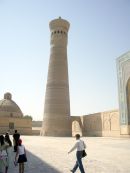 one of several restaurants built on two sides of a large square well. The waiters spoke english and you chose the salads you wanted from a selection brought on a tray. There was also plov – rice and carrots with meat if you wanted it – and beef, lamb or chicken kebabs as well as
one of several restaurants built on two sides of a large square well. The waiters spoke english and you chose the salads you wanted from a selection brought on a tray. There was also plov – rice and carrots with meat if you wanted it – and beef, lamb or chicken kebabs as well as french fries for those suffering withdrawal symptoms. We enjoyed very good food and a couple of local cool beers as we sat in the cool of the evening with fountains playing on the water – memorable!
french fries for those suffering withdrawal symptoms. We enjoyed very good food and a couple of local cool beers as we sat in the cool of the evening with fountains playing on the water – memorable!
And so we came to the ancient walled city of Khiva. 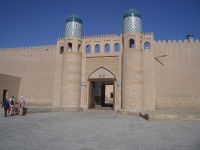 The clay city walls are studded with 40 bastions and also some graves. These were a useful defence since religious beliefs forbade walking over them. The Old town still had the 4 main gates and we had to park outside the walls and walk to our hotel. The hotel had a very grand entrance not unlike the picture below. but inside the students studies had been turned into hotel rooms. The rooms were very basic but comfortable and the courtyard made it an idyllic place to stay.
The clay city walls are studded with 40 bastions and also some graves. These were a useful defence since religious beliefs forbade walking over them. The Old town still had the 4 main gates and we had to park outside the walls and walk to our hotel. The hotel had a very grand entrance not unlike the picture below. but inside the students studies had been turned into hotel rooms. The rooms were very basic but comfortable and the courtyard made it an idyllic place to stay.
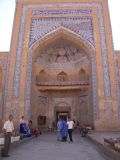
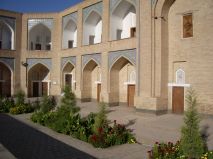 There were many fantastic sights to see in Khiva and we spent the best part of 6 hours on a guided walking tour. it was a shame that the visit was so intense as we could not really appreciate the history and beauty of all of them.
There were many fantastic sights to see in Khiva and we spent the best part of 6 hours on a guided walking tour. it was a shame that the visit was so intense as we could not really appreciate the history and beauty of all of them.
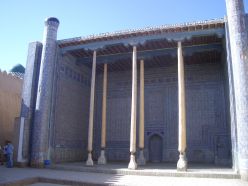
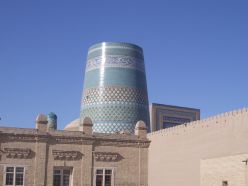
Click here to see some more photos of this phase of our journey.
And so we came to the end of another adventure. Annie and I had a really great time and were grateful for the opportunity to see wonderful scenery, amazing buildings and meet some really friendly people.

